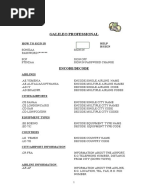Sabre Manual Training
This is a question that comes back again and again. “I am interested in taking up sabre. What is the best manual to begin with?” My personal answer to this is: “The one you prefer.” Few people realize the number of manuals that were written on that subject. For the 19th century alone, the Schola Artis database gives us close to 200 manuals, with many probably missing.
In this sea of sources, it is easy to get lost. Here are my recommendations on how you can manage to find a good workable source. What are your interests?
This is the first question to ask yourself. I could tell you to take on the French fencing manual of 1877, but if that time period does not really appeal to you, then chances are you won’t stick to it and in the end, you won’t get much out of it.
Sabre Basic Course Manual Edition 1.0. SABRE KEYBOARD LAYOUT. 10-Jan-17 Sabre Basic Course Page 8 Term Definition. Sabre Training Manuals. Click on the links below to download the training manuals –. You will need the following software to open the training manuals –.
So which historical period do you like? What kind of sabre? Are you interested in a specific area? Establishing this will help to determine what you should be looking for. If you want to learn how to use an 1804 cutlass, then duelling sabre manuals are probably not the best source. Is there already someone near you? Too often, people tend to forget to look around them.
Maybe a HEMA group is already active training something that would interest you, or that is relatively close. If you are a beginner, getting to train with someone who is experienced will already catapult your training forward and save you hours if not years of fumbling. Experiencing classical or even Olympic fencing can give you a good base to start from, and a very solid training regimen. If you can attend such classes, I would recommend them to anyone who has an interest, regardless of experience.
How much time will you be spending on this manual? Many HMA groups practice longsword or other Medieval or Renaissance arts and sometimes decide they want to do some sabre on the side.
Sabre Interact Training Manual

Sabre Online Training Manual
While I encourage anyone to try sabre, keep in mind that if it is not your main practice, you might end up having to spend more time reworking the basics, especially things like the lunge if your system does not already cover it. In that case, choosing a simple system which details the main actions well, gives you simple drills to work on and which already has a lot of available interpretations will help you a lot. Do not hesitate to video yourself and ask for guidance from experienced sabre instructors online. Here are some examples of simple, well-known sources for different eras and regions available in English (reading this blog, I expect that you are comfortable with that language). For this reason, you will see that Anglophone countries have longer lists than others, which is an issue that is slowly getting better in HMA.
2001 Honda Shadow Sabre Manual
Note that some will come back a few times as their systems were practised in different places and at different times. Be aware that I am listing here the manuals which are easily available and have enough of a following to help beginners. I am also referencing manuals that I personally know of and can vouch for, there are many others I have not read, and as a result, could not in good faith recommend. So this is not the “official historical sabre list”, only Max’s list.
If you do think that titles are missing, do let me know. Finally, this is not a list of the best or even must-haves of sabre manuals. There are many more manuals around that offer more or at least different material. I simply noted those which I think are the best to start from. Do read as much as you can and experiment outside of the main currents.
Update: I have added the different traditions in parenthesis where they are relevant. While it can be argued that every manual is part of a tradition, I have included none where I feel that the style is too different from the others so as not to add any confusion. United-Kingdom and Commonwealth Early 1800s Mid 1800s Late 1800s.
France Early 1800s Mid to late 1800s. Italy Late 1800s Early 1900s. Poland 1600s (note that we are getting here in the speculative area, as there are no manuals for this period. Yet, this is a solid system). Holland Mid 1800s Early 1900s. United States Early 1800s Mid 1800s Late 1800s Early 1900s. Austria Early 1800s.
Greece Mid 1800s.
Most Viewed Pages
- Bobcat 2300 Parts Manual
- Chapter Reinforcement And Study Guide Principles Of Ecology
- Aatcc Technical Manual 2017
- Case Super M Backhoe Service Manual
- Workshop Manual Mitsubishi L300 2001
- 2015 Honda Cbr600rr Repair Manual
- Ford Escort Rs Turbo Haynes Manual
- Haynes Manual For Renault Megane 2002
- Raptor Repair Manual
- Study Guide For Ambulance Driver Certificate
- Using Econometrics A Practical Guide Answer Key
- Yamaha 15hp 2 Stroke Outboard Motor Manual
- Padis Implementation Guide
- Vicon Spreader Parts Manual
- Mori Seiki Service Manual Mt2017
- Gmc Envoy Sle Owner Manual
- Toyota Sequoia Manual
- Neural Networks Guide
- Cat 432e Manual
- Solution Manual Cost Accounting Horngren 14th Edition
- Mo 2316 Manual Juki